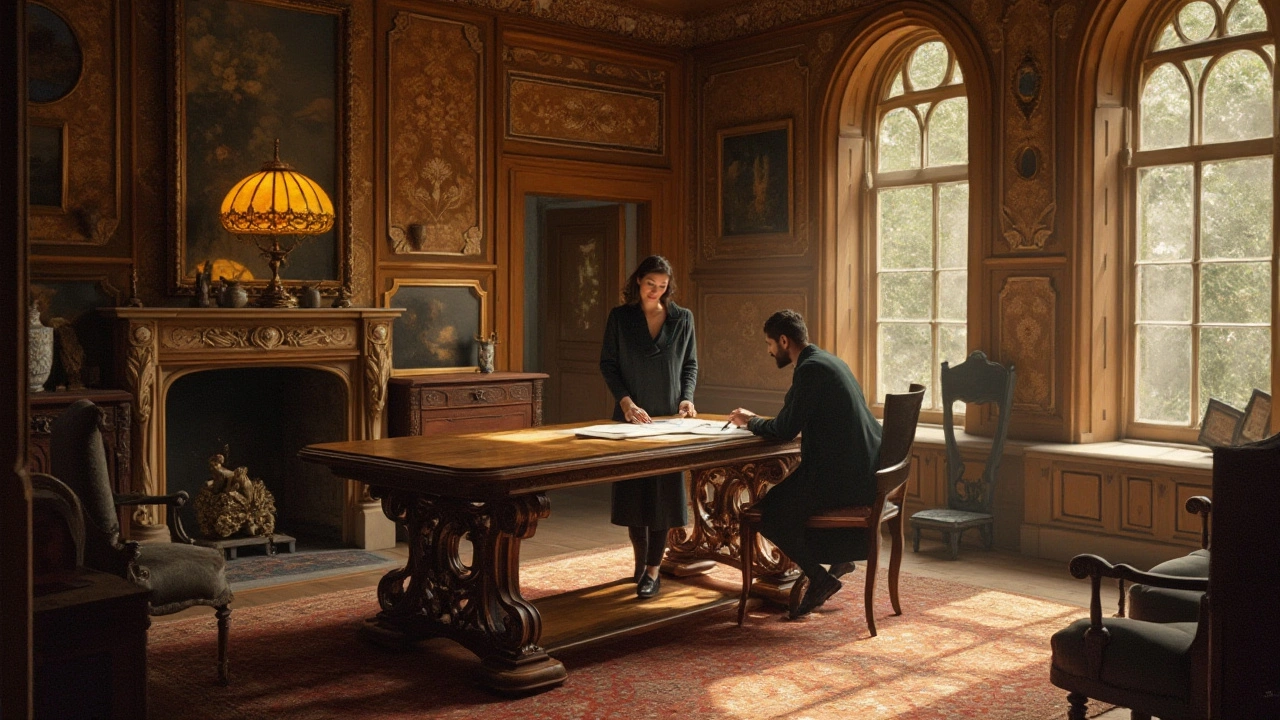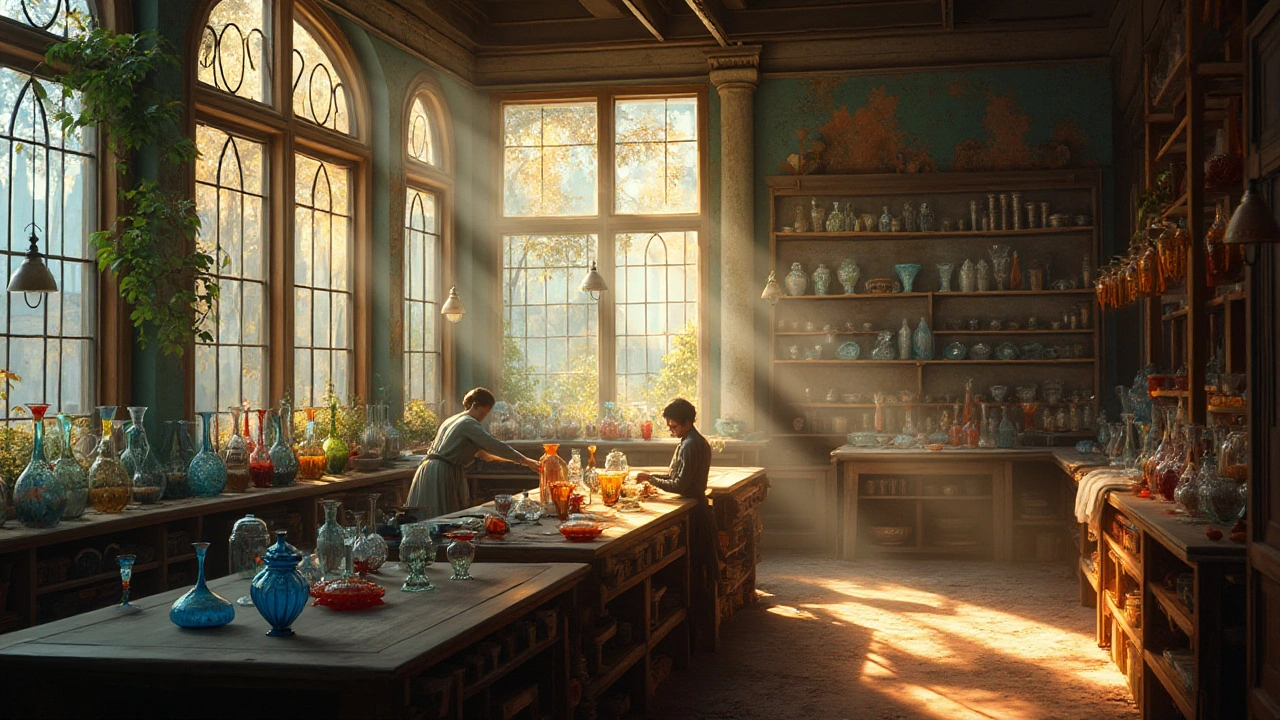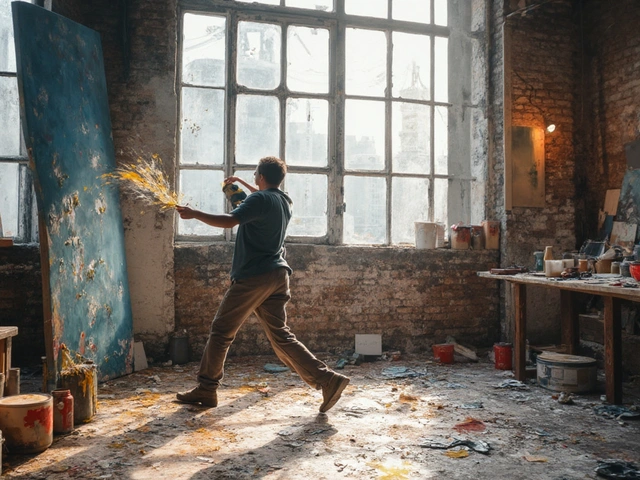Art Nouveau, a groundbreaking art and design movement, emerged in the late 19th century. It stood as a counter-movement to the industrialization that was sweeping across the world, seeking to reinstate a sense of artistry and craftsmanship into everyday objects and architecture.
This style is notable for its elegant lines, organic forms, and intricate details, drawing inspiration from the natural world. It encompassed a variety of materials and methods, making every piece unique yet unified under the same aesthetic vision. This framework provided artists and designers an unusual freedom to experiment.
Unlike other art movements, Art Nouveau dissolved the boundaries between different forms of art, influencing everything from architecture to typography. This comprehensive reach was one of its defining features, inviting people to live amongst beauty.
- Origins of Art Nouveau
- Key Characteristics and Design Elements
- Influential Artists and Architects
- Impact on Modern Design
- Preservation and Appreciation Today
Origins of Art Nouveau
In the late 19th century, a new art movement began to take shape across Europe, known as Art Nouveau. This was a time when industrialization was making machines and mass production the norm, and artists and designers were searching for a new way to express creativity and individuality. The movement really started to gel in the 1890s, partly as a reaction against the rigid standards of academic art and partly as a response to the rapid changes brought by the industrial era. Influences came from multiple directions, including the Arts and Crafts movement in England, Japanese art with its flowing, natural lines, and even Celtic motifs, all contributing to its distinctive style.
An essential driving force behind Art Nouveau was the idea of creating art that could be integrated into daily life, transforming everything from architectural structures to simple household items. The notion was that beauty and art should not be confined to museums but should be part of the environment around us. One of the defining principles was the idea that art and craftsmanship should have equal status. This viewpoint encouraged artists to experiment across various media, leading to innovative designs in furniture, glassware, ceramics, and graphic arts. Art Nouveau landmarks began appearing all over Europe, with cities like Paris, Brussels, Barcelona, and Vienna becoming focal points for this avant-garde style.
Among the notable figures credited with spearheading the movement were Hector Guimard in Paris, with his sensual designs such as those he created for the Paris Métro entrances, and Antoni Gaudí in Barcelona, whose visionary buildings like Casa Batlló defied traditional architectural norms. The movement’s reach was vast, with an almost democratic appeal that said art is for everyone. Designers and architects such as Victor Horta and Louis Comfort Tiffany in the United States also embodied the Art Nouveau ethos in their works, contributing to its growing prestige and popularity.
"Art Nouveau was the style of youth against the establishment," noted Stéphane Ricordel in a retrospective exhibition, highlighting its revolutionary roots.
Art Nouveau wasn't just about decoration; it was steeped in a philosophy that embraced and celebrated natural beauty. Organic forms like flowers and plants, along with flowing, curved lines, were prominent in designs, a stark contrast to the linear, mechanical patterns that prevailed due to industrialism. This approach fostered a deeper appreciation for nature and the environment, which resonated with many during a time of rapid urbanization. Several exhibitions and publications promoted this new art form, with the Maison de l'Art Nouveau gallery in Paris and magazines like Jugend in Germany being pivotal in spreading its aesthetics and principles.
The international reach of Art Nouveau illustrates its versatility and adaptability, easily blending with local traditions to create unique regional variations. Countries like Italy, Austria, and Scotland each had their distinctive take on the style, ranging from the soft, organic lines in Italy's Liberty Style to the geometric patterns embraced in Vienna's Secession movement. Despite its eventual decline with the rise of modernist movements and the outbreak of World War I, the legacy of Art Nouveau endures, continuing to inspire contemporary designers and architects to this day.
Key Characteristics and Design Elements
Art Nouveau, or 'New Art,' was born from a desire to erase the dividing line between art and craftsmanship. Its vision was expansive, incorporating architecture, furniture, jewelry, typography, and many more aspects of daily life. The most striking trait of Art Nouveau is its emphasis on organic forms and flowing lines. Characterized by sinuous, elongated, and curving shapes, the designs often draw inspiration from the delicate, languid forms found in nature, such as vines, flowers, and even human forms. These curvilinear patterns add to the aesthetic richness, making art quite literally part of life.
Another element often seen is the use of asymmetry. Breaking away from traditional forms that revered symmetry, Art Nouveau designs were often intentionally unbalanced, creating dynamic compositions that intrigue rather than settle the viewer’s eye. Designs were filled with intricate details, showing an admiration for meticulous craftsmanship. This attention to detail and emphasis on individualism is what ultimately set the movement apart. A famous example being Antoni Gaudí's architectural works in Barcelona, where fluid, organic shapes effortlessly grace the urban landscape, breathing life and art into the environment.
"Art is not freedom from discipline, but disciplined freedom." - John F. KennedyMaterials were equally significant in defining these designs. The movement encouraged the use of novel materials and techniques, especially in glass and wrought ironworks. This was the era when Louis Comfort Tiffany’s glass lamps became icons. Driven by the quest for beauty and innovation, artists explored the transparency, color, and strength of glass, often in the form of stained-glass windows or lamps, which provided ambient glow and color to a space. Metals such as iron were bent and forged in ways that mimicked the curves of natural forms, adding both structure and beauty.
Color palettes in Art Nouveau are typically soft and muted, allowing the forms and details to take center stage. The shades are often inspired by natural tones, making use of earthy browns, soft greens, and refreshing blues. This color scheme reinforces the organic feel of the movement, promoting harmony between the decor and the environment it inhabits. Decorative arts often borrowed elements from different cultures and historical periods, resulting in a rich tapestry of styles. Enamels, ceramics, and textiles frequently reflected this, incorporating intricate patterns and gilded elements to make ordinary objects extraordinary.
One cannot overlook the typography that emerged from this period, with letters that seemed to flow and twist as naturally as vines and stems. This radical departure from the rigid typefaces that dominated print reflected the shift toward a more organic and decorative approach. Graphic design elements, like posters and book covers, often involved an integration of text and image, which transformed simple communication into a captivating art form. Recognizing this timeless beauty and craftsmanship in everyday life was integral to the Art Nouveau philosophy, making it a movement that profoundly shaped modern aesthetics. Its fusion of art and design continues to influence creators today, inviting us to find art in the most unexpected places.

Influential Artists and Architects
Art Nouveau captivated the imaginations of many prolific figures whose works left a lasting mark on the art and design world. Among these luminaries was Hector Guimard, a French architect best known for his stunning entrances to the Paris Métro. With their swirling ironwork and organic motifs, Guimard's designs epitomized the movement, seamlessly blending aesthetics with utility. His work not only beautified the urban landscape but also made fine arts accessible to the daily commuter. Meanwhile, in Belgium, Victor Horta emerged as a central figure. His buildings, such as the Hôtel Tassel, featured innovations like wrought-iron railings and large stained glass windows, bringing an intimate connection between light and space that's still admired today.
Louis Comfort Tiffany, an American designer, played a pivotal role in popularizing Art Nouveau across the Atlantic. Tiffany's stained glass works, particularly his exquisite lamps, are celebrated for their vibrant colors and detailed craftsmanship. They became icons of decorative arts and showcased the movement's ethos, where utility meets beauty. Another visionary, Alphonse Mucha, enthralled Europe with his elaborate posters and illustrations. Mucha's flowing lines and lush palettes were seen everywhere from posters to jewelry, shaping the visual culture of the era. He believed art should be a centerpiece of everyday life, a belief that resonated deeply with the times.
Taking the movement further into architecture, Antonio Gaudí of Spain infused Art Nouveau with his own unique flair. His iconic Barcelona landmark, Sagrada Família, remains a testament to his genius. Gaudí's emphasis on natural forms and organic architecture redefined cityscapes with possibilities only limited by the imagination. He once stated,
"The straight line belongs to men, the curved one to God,"reflecting how nature inspired so much of his innovative design. Through the works of these visionaries, Art Nouveau presented not just an aesthetic choice but a philosophy of life that embraced art's potential to transform environment and society.
As Art Nouveau spread across the world, its impact diversified. Charles Rennie Mackintosh, a Scottish architect, contributed by introducing a more rectilinear approach to the style. His design principles influenced the Glasgow School of Art, while his furniture emphasized geometric simplicity. This melding of styles demonstrated Art Nouveau's adaptability and its ability to inspire future modernist movements. In Italy, Carlo Bugatti made a name for himself with his exotic furniture designs. His pieces, marked by unusual forms and materials, demonstrated how Art Nouveau could encapsulate cultural identities and historical references. Such diversity within the movement enabled a cultural dialogue, artfully bridging innovative design with traditional craftsmanship.
Though each artist and architect brought their unique touch to Art Nouveau, they shared a common vision: art and craftsmanship should coexist harmoniously in our everyday surroundings. This lasting legacy keeps Art Nouveau relevant today, as it continues to inspire artists and designers who seek to transcend the ordinary, truly embodying a fusion of beauty and craftsmanship. With such a vibrant past and influence, it's easy to appreciate why Art Nouveau remains celebrated as an emblem of creativity and expression.
Impact on Modern Design
In the realm of design, few movements have left as lasting an impression as Art Nouveau. Emerging during a time of industrial upheaval, this style boldly declared its departure from mass-produced monotony, focusing instead on individual artistry and craftsmanship. Today, its legacy is seen not merely in aesthetics, but also in the values and principles that guide modern designers. By reconnecting with organic forms, Art Nouveau reintroduced the beauty found in nature to urban landscapes, something many contemporary designers strive to achieve through sustainable practices and eco-friendly materials.
Art Nouveau has provided a unique blueprint for integrating art with utility, a philosophy that resonates heavily in today's design challenges. Its influence is evident in the prominence of curvilinear shapes and the embrace of asymmetry in modern architecture and home decor. This departure from the rigid lines of prior movements allows for creations that resonate with human emotions and experiences. The style's use of advanced decorative arts has inspired creators to infuse everyday objects with artistic value, ensuring that functionality does not have to sacrifice beauty.
Moreover, many contemporary artists continue to draw on Art Nouveau's principles, particularly when designing graphics and digital media that embody fluidity and an organic feel. The movement's emphasis on craftsmanship has encouraged a similar burgeoning interest in bespoke, handcrafted items in our current digital age. This link between past and present shows that Art Nouveau's core tenet—the marriage of art and life—remains just as relevant today, perhaps even reclaiming some of its original vigor in a world riddled with digital oversaturation.
According to art historian Judith Flanders, "The uniqueness of Art Nouveau was its belief that beauty is present in all objects when approached from an artistic perspective." This perspective has urged modern creators to reconsider functionality and aesthetics as more entwined than ever, breaking down the barriers that often segregate practical design from artistic endeavor.
Another facet of modern design where Art Nouveau's touch is unmistakable is in typography. The movement's unique take on fonts—with their flowing, organic style—has inspired today's designers to create typefaces that evoke elegance and sophistication. This trend highlights how the past continuously shapes the present, embedding itself into the framework of what we consider visually appealing in the digital world.
An interesting parallel can be drawn between the sustainability focus of today's top designers and the Art Nouveau ethos. While the movement never explicitly focused on environmental issues, its core appreciation for nature foresaw our current ecological collective consciousness. Many firms now echo this idea, using sustainable materials while aiming for an aesthetic that reflects the harmony found in nature.
In sum, Art Nouveau didn't merely decorate the past; it planted seeds for the future. Its impact on modern design manifests in a myriad of ways, from architectural lines and bespoke artistry to environmental symbiosis and tech-driven typography. While society constantly evolves, the ideals that Art Nouveau put forth continue to inspire and shape our creative landscapes, whispered through every line and curve found in today's designs.

Preservation and Appreciation Today
In today's world, the preservation and appreciation of Art Nouveau continue to grow as people rediscover its timeless charm and cultural significance. This revival stems from a deepening appreciation for craftsmanship and a desire to keep history alive through architecture, furniture, and decorative arts. Various cities worldwide boast remarkable examples of Art Nouveau buildings and landmarks, which stand as testaments to the enduring appeal of this aesthetic. Ensuring these treasures remain intact involves meticulous restoration efforts that honor the unique blend of artistic flair and functional design inherent in each piece. This attention to detail is crucial, not only to preserve the physical structures but also to keep alive the philosophies and ideals that shaped their creation.
Efforts in preserving Art Nouveau go beyond mere aesthetics—they encompass a dedication to understanding the context and skills required for these works. Dedicated craftsmen and artisans often undergo specialized training to repair and restore intricate details using traditional techniques, which has inspired a renaissance in craft-based education. Institutions and museums globally are pivotal in this mission, housing exhibitions that share the stories behind these designs while educating the public on their significance. Organizations like the World Art Nouveau Day, celebrated every June 10th, emphasize the cultural impact by encouraging communities to engage with local Art Nouveau heritage.
The appreciation of Art Nouveau continues to influence contemporary designers who find value in its principles. This influence can be seen in modern designs that incorporate flowing lines and natural motifs akin to those used by past masters. Often seen as a remedy to the starkness of minimalism, Art Nouveau inspires by encouraging a resurgence in pattern and ornamentation that value a handcrafted touch. As sustainable design becomes more significant, the movement's celebration of artisanal skill over mass production offers a model for future practices.
"Art Nouveau's core values in design and craftsmanship offer not only aesthetic pleasure but a sustainable ethos for new generations," states renowned art historian Dr. Lucy Worsley.
Governments and private entities often work together to maintain the legacy of Art Nouveau. Conservation grants and funding initiatives are key components of successful preservation projects, ensuring that future generations can enjoy these magnificent pieces of history. This communal effort often extends to online platforms, where virtual tours and digital archives make these works accessible to a broader audience. Digital reconstructions of lost Art Nouveau treasures have become an increasingly popular way to experience the whimsy and beauty of the era virtually.
Appreciation for Art Nouveau also manifests in its influence on tourism. Tourists flock to cities like Brussels, Barcelona, and Prague, where stunning examples of this movement invite exploration. Local guides and historians offer tours that not only delve into the architectural brilliance but also share tales of the lives and times of the artists behind the scenes. Such narratives provide a richer context, allowing individuals to connect emotionally with the pieces they observe. As interest continues to grow, Art Nouveau remains a tangible link to the past—a testament not just to its beauty but to a shared human heritage that transcends time and remains relevant in contemporary society.




